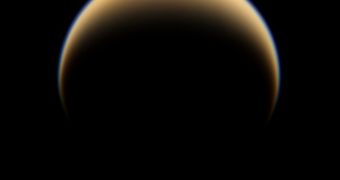Among astronomers, Saturn's largest moon Titan is primarily known for being the only object in the solar system other than Earth to have liquid chemicals on its surface. A group of investigators in the United States finally provides an explanation of where these chemicals originate.
Both of Titan's poles are adorned with lakes made up of liquid hydrocarbons, a class of chemical compounds that include methane and ethane. At an average temperature of 90 Kelvins, water turns into a type of ice that is harder than granite.
Yet, the moon features an atmosphere made entirely out of hydrocarbons, especially methane. Its clouds and fogs are also made up of the same stuff, so researchers have always wondered about their origins. Where Titan's rainstorms and plentiful lakes came from was also a reason for debate.
Scientists from the California Institute of Technology (Caltech) recently developed a new computer model, which they say is very efficient at resolving most of these issues in a very coherent manner.
The model may also be useful in explaining three important mysteries related to this celestial body. The first is finding out why most of the hydrocarbon lakes on Titan tend to cluster around its poles, rather than be spread uniformly across the moon.
Scientists also noticed that low-latitude areas near the equator appeared to be very dry. Yet the Huygens lander – which was released by the NASA Cassini orbiter – discovered what appeared to be runoff channels, potentially caused by rain.
The third important mystery is the way in which clouds in the thick atmosphere surrounding Titan cluster together, especially at “southern middle and high latitudes,” Daily Galaxy reports.
“We have a unified explanation for many of the observed features. It doesn't require cryovolcanoes or anything esoteric,” explains the Caltech Frank J. Gilloon professor of environmental science and engineering, Tapio Schneider.
What separates this particular model from any other of its type is the fact that it was able to reproduce the current arrangement of clouds on Titan. That is to say, the cloud pattern showed the same tendency of clustering at middle and high latitudes.
“It's amazing to be watching such familiar activity as rainstorms and seasonal changes in weather patterns on a distant, icy satellite. These observations are helping us to understand how Titan works as a system, as well as similar processes on our own planet,” Elizabeth Turtle explains.
The expert was the lead author of the new study presenting the model. She is also a Cassini imaging team associate researcher at the Johns Hopkins University Applied Physics Lab (JHU-APL), in Laurel, Maryland, Daily Galaxy reports.

 14 DAY TRIAL //
14 DAY TRIAL //